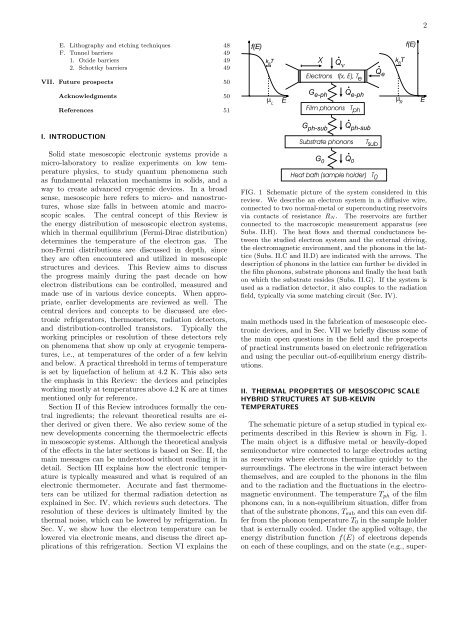Thermal properties in mesoscopics: physics and ... - ResearchGate
Thermal properties in mesoscopics: physics and ... - ResearchGate
Thermal properties in mesoscopics: physics and ... - ResearchGate
Create successful ePaper yourself
Turn your PDF publications into a flip-book with our unique Google optimized e-Paper software.
E. Lithography <strong>and</strong> etch<strong>in</strong>g techniques 48<br />
F. Tunnel barriers 49<br />
1. Oxide barriers 49<br />
2. Schottky barriers 49<br />
VII. Future prospects 50<br />
Acknowledgments 50<br />
References 51<br />
I. INTRODUCTION<br />
Solid state mesoscopic electronic systems provide a<br />
micro-laboratory to realize experiments on low temperature<br />
<strong>physics</strong>, to study quantum phenomena such<br />
as fundamental relaxation mechanisms <strong>in</strong> solids, <strong>and</strong> a<br />
way to create advanced cryogenic devices. In a broad<br />
sense, mesoscopic here refers to micro- <strong>and</strong> nanostructures,<br />
whose size falls <strong>in</strong> between atomic <strong>and</strong> macroscopic<br />
scales. The central concept of this Review is<br />
the energy distribution of mesoscopic electron systems,<br />
which <strong>in</strong> thermal equilibrium (Fermi-Dirac distribution)<br />
determ<strong>in</strong>es the temperature of the electron gas. The<br />
non-Fermi distributions are discussed <strong>in</strong> depth, s<strong>in</strong>ce<br />
they are often encountered <strong>and</strong> utilized <strong>in</strong> mesoscopic<br />
structures <strong>and</strong> devices. This Review aims to discuss<br />
the progress ma<strong>in</strong>ly dur<strong>in</strong>g the past decade on how<br />
electron distributions can be controlled, measured <strong>and</strong><br />
made use of <strong>in</strong> various device concepts. When appropriate,<br />
earlier developments are reviewed as well. The<br />
central devices <strong>and</strong> concepts to be discussed are electronic<br />
refrigerators, thermometers, radiation detectors,<br />
<strong>and</strong> distribution-controlled transistors. Typically the<br />
work<strong>in</strong>g pr<strong>in</strong>ciples or resolution of these detectors rely<br />
on phenomena that show up only at cryogenic temperatures,<br />
i.e., at temperatures of the order of a few kelv<strong>in</strong><br />
<strong>and</strong> below. A practical threshold <strong>in</strong> terms of temperature<br />
is set by liquefaction of helium at 4.2 K. This also sets<br />
the emphasis <strong>in</strong> this Review: the devices <strong>and</strong> pr<strong>in</strong>ciples<br />
work<strong>in</strong>g mostly at temperatures above 4.2 K are at times<br />
mentioned only for reference.<br />
Section II of this Review <strong>in</strong>troduces formally the central<br />
<strong>in</strong>gredients; the relevant theoretical results are either<br />
derived or given there. We also review some of the<br />
new developments concern<strong>in</strong>g the thermoelectric effects<br />
<strong>in</strong> mesoscopic systems. Although the theoretical analysis<br />
of the effects <strong>in</strong> the later sections is based on Sec. II, the<br />
ma<strong>in</strong> messages can be understood without read<strong>in</strong>g it <strong>in</strong><br />
detail. Section III expla<strong>in</strong>s how the electronic temperature<br />
is typically measured <strong>and</strong> what is required of an<br />
electronic thermometer. Accurate <strong>and</strong> fast thermometers<br />
can be utilized for thermal radiation detection as<br />
expla<strong>in</strong>ed <strong>in</strong> Sec. IV, which reviews such detectors. The<br />
resolution of these devices is ultimately limited by the<br />
thermal noise, which can be lowered by refrigeration. In<br />
Sec. V, we show how the electron temperature can be<br />
lowered via electronic means, <strong>and</strong> discuss the direct applications<br />
of this refrigeration. Section VI expla<strong>in</strong>s the<br />
f(E)<br />
k B T<br />
L<br />
E<br />
X<br />
•<br />
Q Electrons f(x, E), T e<br />
G e-ph<br />
•<br />
Qe-ph Film phonons T ph<br />
G ph-sub<br />
•<br />
Qph-sub Substrate phonons T sub<br />
G 0<br />
•<br />
Q0 Heat bath (sample holder) T 0<br />
•<br />
Qe k B T<br />
R<br />
f(E)<br />
FIG. 1 Schematic picture of the system considered <strong>in</strong> this<br />
review. We describe an electron system <strong>in</strong> a diffusive wire,<br />
connected to two normal-metal or superconduct<strong>in</strong>g reservoirs<br />
via contacts of resistance RN . The reservoirs are further<br />
connected to the macroscopic measurement apparatus (see<br />
Subs. II.H). The heat flows <strong>and</strong> thermal conductances between<br />
the studied electron system <strong>and</strong> the external driv<strong>in</strong>g,<br />
the electromagnetic environment, <strong>and</strong> the phonons <strong>in</strong> the lattice<br />
(Subs. II.C <strong>and</strong> II.D) are <strong>in</strong>dicated with the arrows. The<br />
description of phonons <strong>in</strong> the lattice can further be divided <strong>in</strong><br />
the film phonons, substrate phonons <strong>and</strong> f<strong>in</strong>ally the heat bath<br />
on which the substrate resides (Subs. II.G). If the system is<br />
used as a radiation detector, it also couples to the radiation<br />
field, typically via some match<strong>in</strong>g circuit (Sec. IV).<br />
ma<strong>in</strong> methods used <strong>in</strong> the fabrication of mesoscopic electronic<br />
devices, <strong>and</strong> <strong>in</strong> Sec. VII we briefly discuss some of<br />
the ma<strong>in</strong> open questions <strong>in</strong> the field <strong>and</strong> the prospects<br />
of practical <strong>in</strong>struments based on electronic refrigeration<br />
<strong>and</strong> us<strong>in</strong>g the peculiar out-of-equilibrium energy distributions.<br />
II. THERMAL PROPERTIES OF MESOSCOPIC SCALE<br />
HYBRID STRUCTURES AT SUB-KELVIN<br />
TEMPERATURES<br />
The schematic picture of a setup studied <strong>in</strong> typical experiments<br />
described <strong>in</strong> this Review is shown <strong>in</strong> Fig. 1.<br />
The ma<strong>in</strong> object is a diffusive metal or heavily-doped<br />
semiconductor wire connected to large electrodes act<strong>in</strong>g<br />
as reservoirs where electrons thermalize quickly to the<br />
surround<strong>in</strong>gs. The electrons <strong>in</strong> the wire <strong>in</strong>teract between<br />
themselves, <strong>and</strong> are coupled to the phonons <strong>in</strong> the film<br />
<strong>and</strong> to the radiation <strong>and</strong> the fluctuations <strong>in</strong> the electromagnetic<br />
environment. The temperature Tph of the film<br />
phonons can, <strong>in</strong> a non-equilibrium situation, differ from<br />
that of the substrate phonons, Tsub <strong>and</strong> this can even differ<br />
from the phonon temperature T0 <strong>in</strong> the sample holder<br />
that is externally cooled. Under the applied voltage, the<br />
energy distribution function f(E) of electrons depends<br />
on each of these coupl<strong>in</strong>gs, <strong>and</strong> on the state (e.g., super-<br />
2<br />
E
















